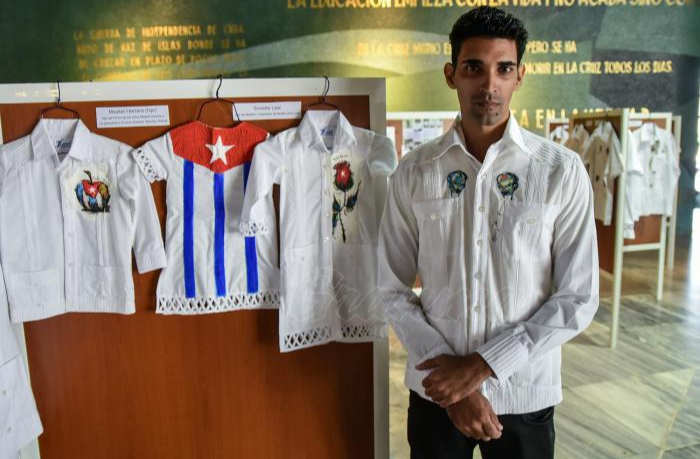Guayaberas by Jordi Leal
by Jorge Rivas Rodriguez
For the young fashion designer Jordi Leal, it is inconceivable that in the Mexican state of Puebla, it has become customary for men to attend weddings dressed in guayaberas as a gala, nor that in Yucatan, where there are dozens of workshops where these garments are made and exported all over the world, this textile product is more admired and recognized than in this land where it arose.
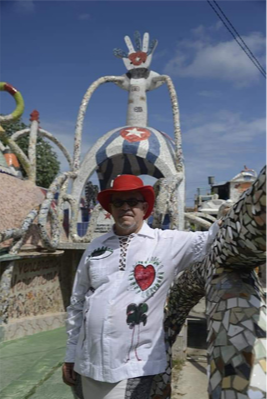
Guayabera by Jordi Leal
Despite the fact that the national press —fundamentally Cuban Television— tries to claim the importance that the use of the guayabera has in the history of the insular culture, even such efforts do not offer the desired results. Hence the need to encourage fashion designers from all over the country to undertake initiatives that, from tradition, arouse interest in the use of this beautiful and practical clothing; management in which Jordi stands out.
The handsome cultural promoter, baptized as The King of Guayaberas, has among his immediate objectives the creation in the capital of an institution that functions as the Guayabera Museum, where his “updated in relation to the traditional” designs are exhibited. There he has conceived to exhibit more than 100 pieces, among which are the images made to the confections enriched with decorations worked by well-known creators of the visual arts, among which the masters José Fúster —with whom he began to put putting this idea into practice—, Zaida del Río, Ever Fonseca, Rebustillo, Nelson Domínguez, Flora Fong, Maikel Herrera, Alicia Leal, Ileana Mulet and the late Cecilio Avilés, among 25 other outstanding visual arts creators.
In this way, once finished, the guayaberas acquire other aesthetic and symbolic dimensions, after the imprint left on them by visual artists; while later they are exhibited by lofty personalities of the insular society; a process that culminates with the taking of the corresponding photographs of each of the characters who became models, which are generally taken by the masters of the lens Roberto Chile, Julio Larramendi and Raúl Cañivano, who take these images in order for them to constitute graphic testimony. of this project and that will later be used in book-catalogues.
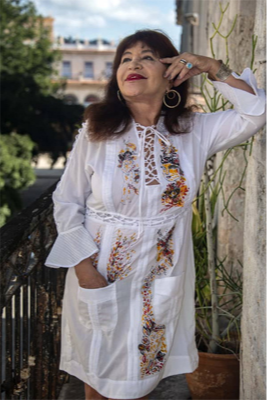
Zaida del Rio
“Wearing the guayabera is like carrying Cuba in oneself,” says the renowned designer, who with his work establishes links between fashion design, plastic artists and those of different expressions of art, such as musicians, singers, dancers. , actors… as well as with other personalities from the sciences, sports, public health, journalism, education…
Referring to his permanent exhibition project, the renowned photographer and model also stated: “It will be a new type of museum, because it is going to show a story that is under construction, but tomorrow it will be that of the guayabera he wore, Omara Portuondo or Javier Sotomayor, to mention some of the figures who have shown their designs”.
One of the mannequins that Jordi has is his little and clever daughter Sonette Leal, seven years old, to whom he also instills love and recognition of this garment that he aspires to be part of the wardrobe of every Cuban, both of the men, as well as women, children and young people; an intention that must also have the support of fashion promoters and costume designers; especially since the management of the Cuban Fund for Cultural Assets (FCBC), as it is well known that this attire considered “label” still does not have great popular acceptance, especially due to the influence that foreign sewing has on national clothing. that is marketed in Cuba; which has motivated the guayabera to be more frequently used in some sectors related to politics, diplomacy, gastronomy and tourism.
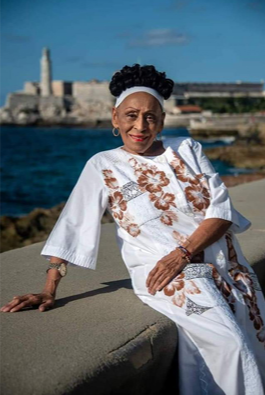
Omata Portuondo
“Future generations -he added- and today’s generations will have a place in the capital that defends the use of our National Garment with a new perspective, a place that will encourage them to use it and recreate it as an invaluable heritage value”.
An idea of what this museum project could represent could be appreciated in the summer of 2019 when Jordi took the exhibition titled Guayaberas JLeal to the José Martí Memorial, in the Plaza de la Revolución. The dreamed image, where for the first time he put more than 80 pieces to the public’s consideration, with the aim, he told the Granma newspaper, “that the new generations make the use of this beautiful and very Cuban garment their own, pride of all the Cubans”. On that occasion, he also exhibited part of the confections that he had made for children up to that moment through the Little Giants collection, in addition to another proposal conceived under the title of My Havana, in evocation of the half-millennium of the founding of the capital. .
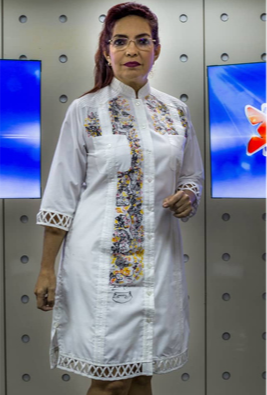
Guayabera by Jordi Leal
The first designs made by Jordi consisted of woven dresses and bathing suits, as well as robes made from cotton fabrics. Shortly after, he became interested in the elaboration of guayaberas, a garment for which he has always experienced great motivation since it is one of the patrimonial attributes of the Cuban nation. Initially, it undertook designs for women and currently has about two dozen collections recreated in this colorful clothing “rejuvenated and modernized through the use of various technical resources typical of the art of sewing and fashion, important difference and diversity since there is a Guayabera Museum in Sancti Spíritus that shows only the most traditional model”, says Jordi.
The history of this dress —according to one of the legends— goes back to the middle of the 18th century, near the Yayabo river1, then Villa del Espíritu Santo (today Sancti Spíritus) after a peasant asked his wife to make him a garment that would be convenient for him to sow the land and store in it the tobacco that he twisted. The woman designed and sewed a white garment with long pockets whose name she baptized as “yayabera” in evocation of the stream of crystal clear waters.
The name derived in “guayabera”2, and very close to that site since 2012 there is the Casa de la Guayabera, where a collection of attire of this type used by relevant personalities from different latitudes is treasured.
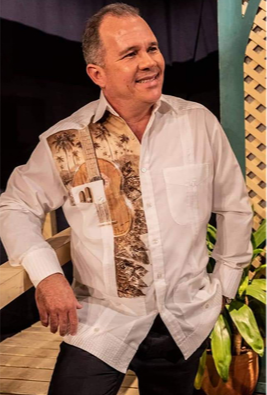
Guayabera by Jordi Leal
A year later (2013), in the well-known El Castillito Recreational Center, in Vedado, the JLeal Modeling Project was created, where a team of professionals and specialists integrates a program erected and led by the young and enterprising designer, who has become an unavoidable reference in the manufacture of a garment that has transcended island borders to gain space and recognition in different regions of Central America, including Mexico, where its origin in the Yucatan region has sometimes been disputed, in addition from Panama and Colombia, among others.
In the cozy space located a few meters from the warm Havana Malecón, Jordi also works in the comprehensive training of children, adolescents and young people who receive classes related to haute couture; the culture of dressing in both sexes and different ages, in correspondence with different moments and situations; as well as elementary notions of hairdressing, self-makeup, nutrition and meditation. Noble dedication that turns El Castillito into a joyful celebration of life through the enrichment of individual and collective spirituality.
But, more than for the quality of their clothing, he puts his guayaberas for public consideration with designs “more up-to-date with these times, more contemporary, that are to the taste and preference of those who wear them, respecting the elements that identify them”, such has said.
His ideology stems from tradition, that is, from the realization of this typical outfit characterized by having four pockets, about 30 buttons, upper and lower yokes at the front and back, two rows of tucks at the front and three at the back; be white and long-sleeved. The proposals (in different colors, generally light, although predominantly white) from this architect of good sewing, delve into essential elements that are quickly perceived by the public, such as the enrichment with pleats on the back in which, with this same technique, he makes suggestive Cuban flags conceived with the same color as the fabric (generally made of thread, linen and cotton); in addition to careful and precise structures in the sleeves —which can be short or extended to the cuffs—, collars and other parts of the comfortable nightgown, made by means of pleats and other ornaments.
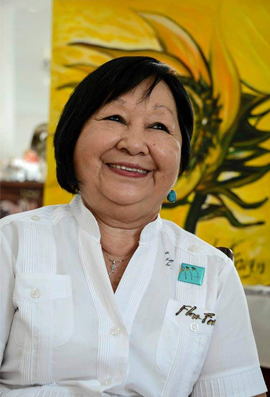
Flora Font
Member of the catalog of the Artistic Agency of Performing Arts Actuar, this friendly designer who has participated in almost a hundred fashion shows and national and international events, has also ventured into other projects related to the good dress of Cubans, from the foundations of tradition, the Caribbean climate, the culture and idiosyncrasy of the islanders, with suggestive clothing for all ages and genders, but especially designed for young people.
Now, his noble ideas in favor of the use of guayaberas demand the attention and interest of the directors and decision-making bodies that are responsible for supporting this valuable project that, ultimately, will contribute to dignifying our sense of belonging and pride. of having been born in this country, with an extraordinary culture in which the guayabera occupies a prominent place. This is how the National Garment of Cuba: the guayabera, already has its home; its Castle and, of course, its King. (Taken from the Portal of Cubarte)
The guayabera, Cuban Heritage, in the creative ideology of Jordi Leal

